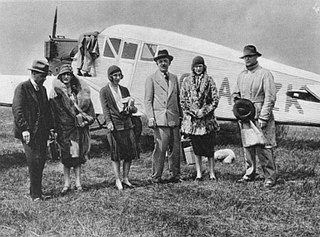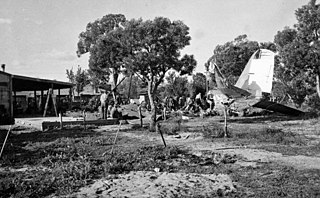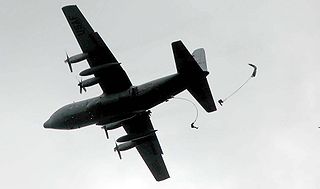
The Handley Page HP.67 Hastings is a retired British troop-carrier and freight transport aircraft designed and manufactured by aviation company Handley Page for the Royal Air Force (RAF). Upon its introduction to service during September 1948, the Hastings was the largest transport plane ever designed for the service.

Royal Air Force Abingdon, or more simply RAF Abingdon, is a former Royal Air Force station near Abingdon, Oxfordshire. It is now known as Dalton Barracks and is used by the Royal Logistic Corps.

Number 33 Squadron of the Royal Air Force operates the Airbus Helicopters Puma HC.2 from RAF Benson, Oxfordshire.

Clifton Hampden is a village and civil parish on the north bank of the River Thames, just over 3 miles (5 km) east of Abingdon in Oxfordshire. Since 1932 the civil parish has included the village of Burcot, 1 mile (1.6 km) east of Clifton Hampden. The 2011 Census recorded the parish population as 662.

On 2 September 2006, a Royal Air Force Hawker Siddeley Nimrod suffered an in-flight fire and subsequently crashed in Kandahar, Afghanistan, killing all fourteen crew members on board. The crash, which occurred during a reconnaissance flight, was the biggest single loss of life suffered by the British military since the Falklands War.

On 30 January 2005 a Royal Air Force Lockheed C-130K Hercules C1, serial number XV179, callsign Hilton 22, was shot down in Iraq, probably by Sunni insurgents, killing all 10 personnel on board. At the time, the incident was the largest single loss of life suffered by the British military during Operation Telic.

Chiselhampton is a village in the civil parish of Stadhampton, on the River Thame, in the South Oxfordshire district, in the county of Oxfordshire, England. It is about 6 miles (10 km) southeast of Oxford. In 1931 the parish named Chislehampton had a population of 136. On 1 April 1932 the parish was abolished and merged with Stadhampton.

The Sutton Wick air crash occurred on 5 March 1957 when a Blackburn Beverley C Mk 1 heavy transport aircraft, serial number XH117, of 53 Squadron Royal Air Force crashed at Sutton Wick, Drayton, Berkshire, England, following a shut-down of one engine and partial loss of power on another. Shortly after take-off, No. 1 engine was shut down as a precautionary measure then whilst on final approach back to RAF Abingdon, No. 2 engine failed to respond to throttle inputs. The aeroplane struck cables and trees 18 minutes after lifting off.

On 6 January 1954 WJ474 a twin-engined Vickers Valetta training aircraft of No. 2 Air Navigation School Royal Air Force crashed near RAF Bovingdon just after takeoff in bad weather.

Little Baldon is a hamlet in the Marsh Baldon civil parish, about 5 miles (8 km) southeast of Oxford in Oxfordshire, south of Marsh Baldon and west of Chiselhampton.

On 4 September 2010, a modified Fletcher FU-24 aeroplane on a parachuting flight from Fox Glacier Aerodrome, New Zealand, crashed shortly after take-off, killing all nine people on board.

The October 1926 Air Union Blériot 155 crash happened on 2 October 1926 at Leigh, Kent when Blériot 155 F-AICQ caught fire in mid-air and crashed while the pilot attempted to make an emergency landing at Penshurst Airfield. Both crew members and all five passengers were killed. This was the first in-flight fire occurring on an airliner.

The 1930 Air Union Farman Goliath crash occurred on 10 February 1930 when a Farman F.63 Goliath of Air Union crashed whilst attempting an emergency landing at Marden Airfield, Kent following the failure of the starboard tailplane. Two of the six people on board were killed.

The Meopham Air Disaster occurred on 21 July 1930 when a Junkers F.13ge flying from Le Touquet to Croydon with two crew and four passengers crashed near Meopham, Kent with the loss of all on board. The report of the inquiry into the accident was made public, the first time in the United Kingdom that an accident report was published.

On 2 July 1949 a Douglas DC-3 aircraft departed from Perth, Western Australia for a night flight of 441 nautical miles (817 km) to Carnarvon. The aircraft climbed to a height of about 500 feet (150 m) and then spiralled almost vertically to the ground, killing all 18 people on board. It crashed about a mile north of Perth airport and burned for over an hour. At the time, it was the worst civil aviation accident in Western Australia.

On 10 March 1949 a Lockheed Lodestar aircraft became airborne at Coolangatta, Queensland, Australia for a flight to Brisbane. Before reaching a height of 300 feet (90 m) it suddenly pitched nose-up, stalled and crashed onto its belly beyond the end of the airstrip.

The 1958 Syerston Avro Vulcan crash was an aviation accident that occurred in England on 20 September 1958 during an air show at RAF Syerston, Nottinghamshire when a prototype Avro Vulcan bomber crashed. All four crew on board and three people on the ground were killed.

The 1993 Llyn Padarn helicopter crash occurred on 12 August 1993, when an RAF Westland Wessex helicopter, serial number XR524, with 3 aircrew and 4 Air Training Corps cadet passengers on board suffered a catastrophic tail rotor failure and plunged into Llyn Padarn, a lake in North Wales. Three passengers were killed.

On 9 November 1971, a Royal Air Force Lockheed Hercules C.1 crashed into the sea off the coast of Livorno by Meloria shoal, Italy, killing all 46 passengers and 6 crew. At the time it was described by Italian officials as the worst military air disaster in Italy in peacetime.























